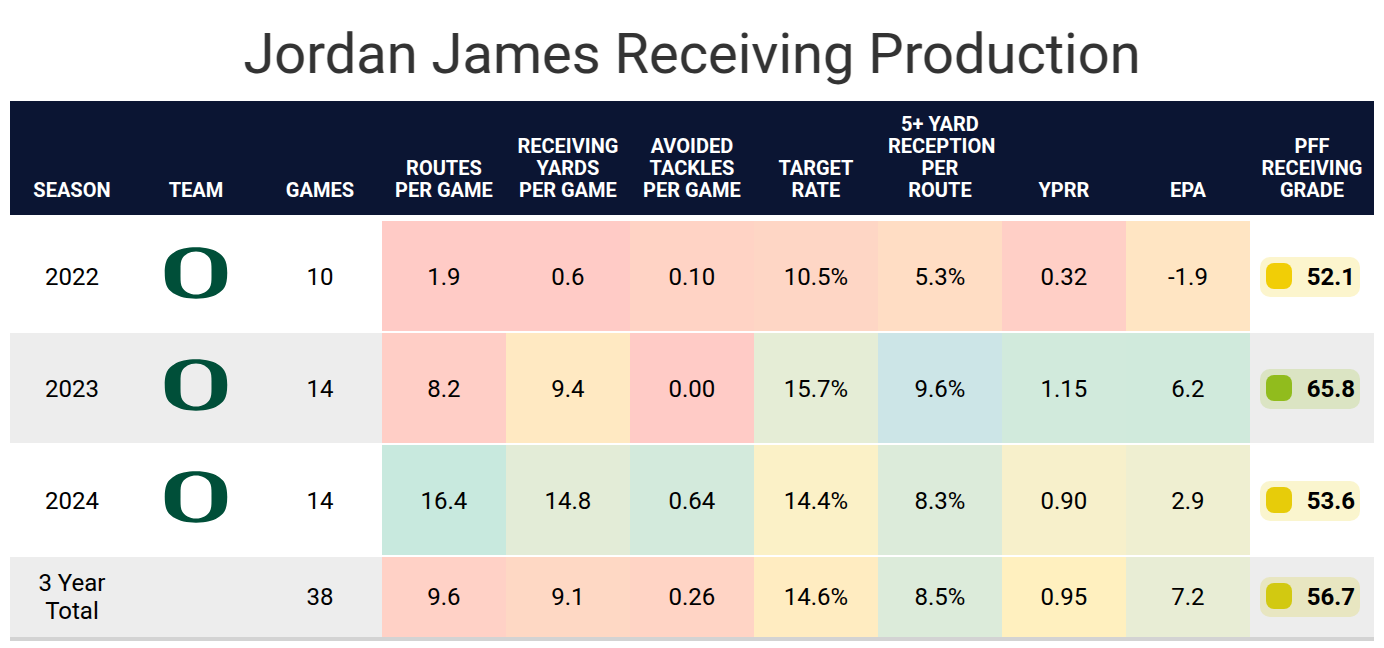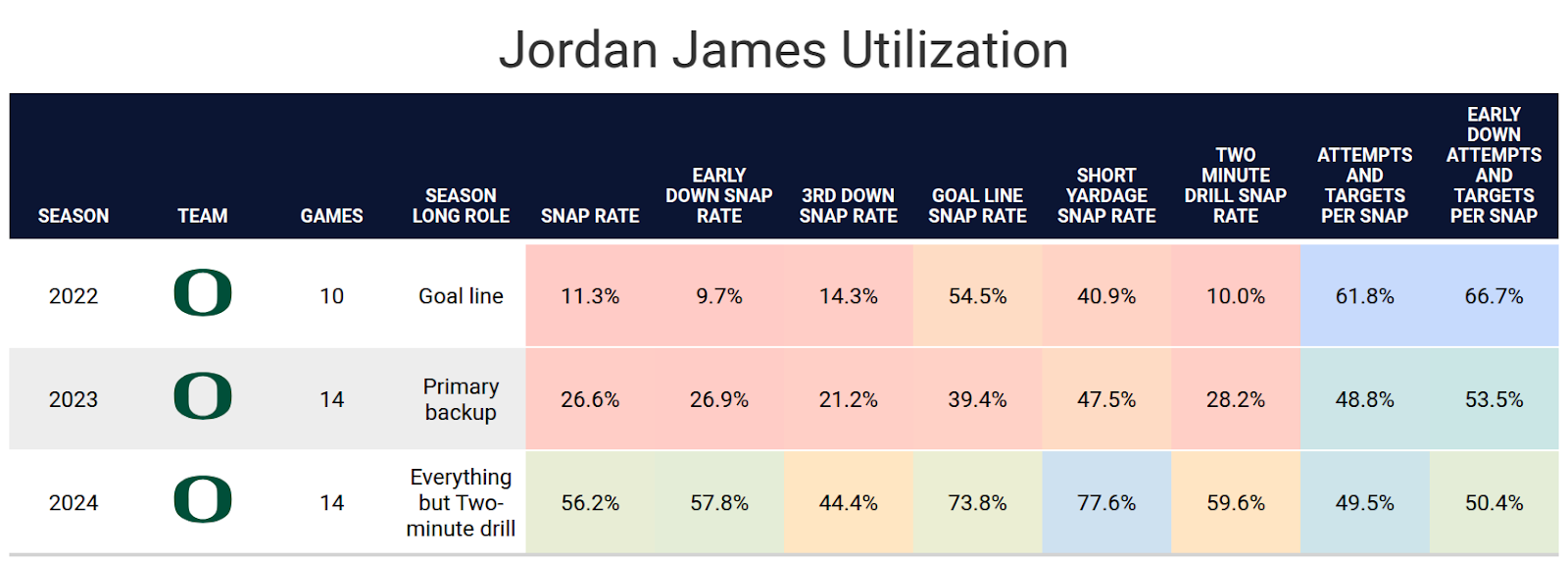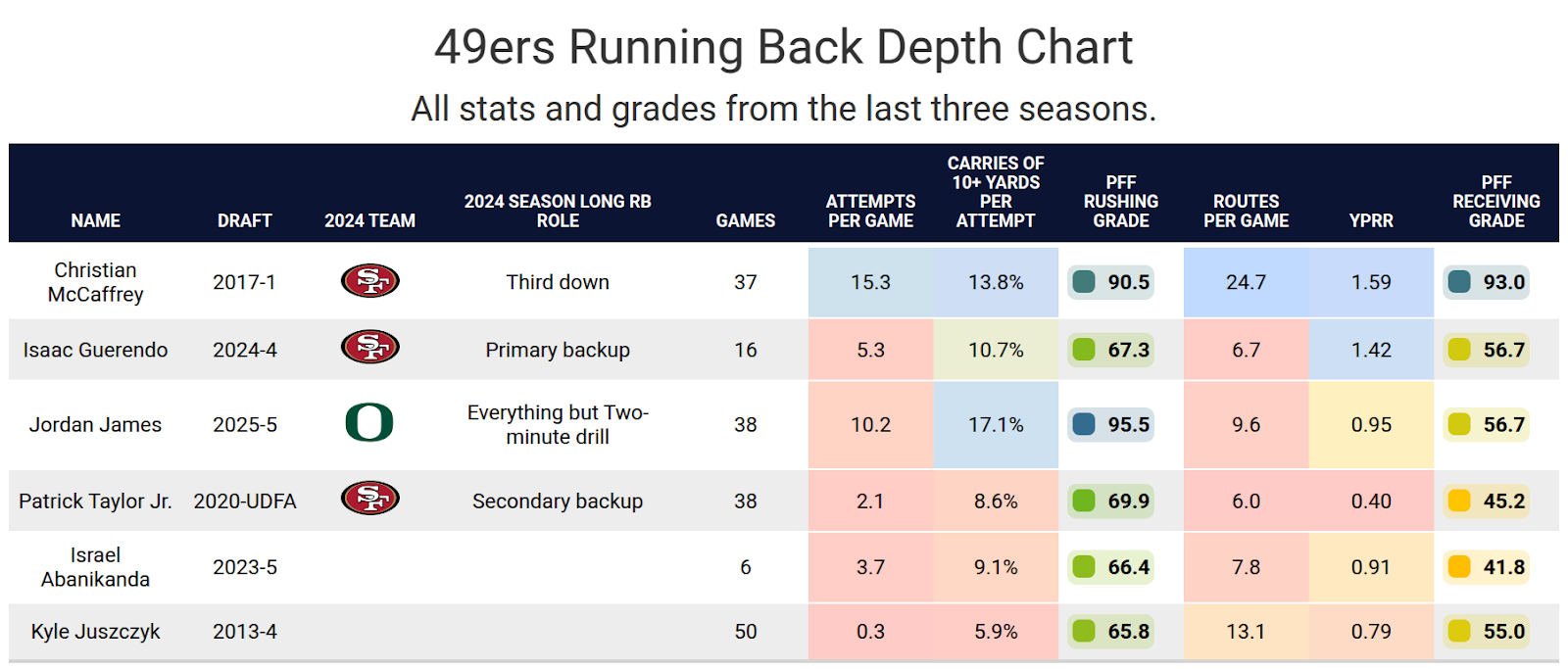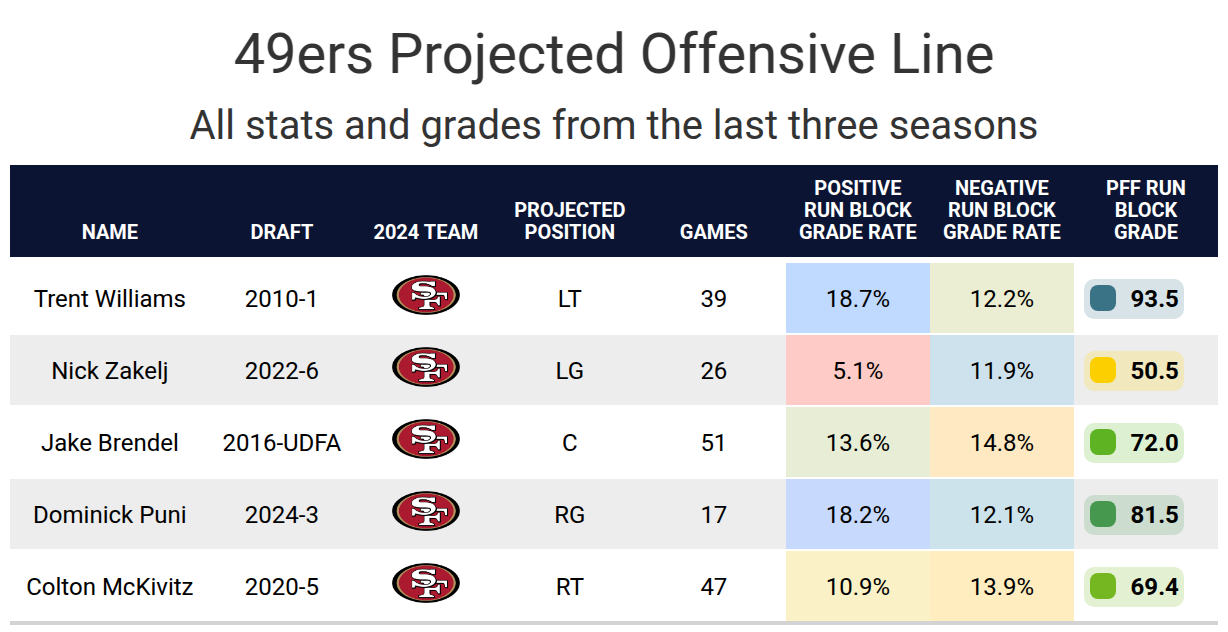- Jordan James excelled on a per-play basis: While James was never one to reach 100 rushing yards consistently, he was very effective at picking up first downs and breaking runs of at least 10 yards.
- An open competition: James will compete with Isaac Guerendo to be the primary backup to Christian McCaffrey for the San Francisco 49ers.
- Subscribe to PFF+: Get access to player grades, PFF Premium Stats, fantasy football rankings, all of the PFF fantasy draft research tools and more!
Estimated Reading Time: 5 minutes
PFF’s Fantasy Football Player Profile series delivers the most in-depth fantasy football analysis available for the 2025 season.
Using PFF’s exclusive data, we evaluate player performance, competition for touches and how teammates and coaching staffs will impact each player's fantasy football outlook.
Last updated: 7:15 a.m. Wednesday, May 7
Click here for more draft tools:
NFL Draft Big Board | Mock Draft Simulator | NCAA Premium Stats
2025 PFF Draft Guide | Mock Draft Hub | Prospect Data Profiles
Draft Position Rankings
Player performance
James spent all three of his collegiate career at Oregon. In his first year, he was buried down the depth chart. In his second year, he surpassed others on the chart to become the clear backup for Bucky Irving. While Irving received roughly twice as much playing time, James received the higher rushing grade, and therefore his overall grade. He was excellent on a per-play basis across the board.
With Irving landing with the Tampa Bay Buccaneers, James took over as the starter in 2024. This led to a significant increase in volume but a slight decrease in efficiency. Most notably, he wasn’t able to break as many long runs. This still left him with a better rushing grade than Irving had the year before in the lead role, but it was a slight decrease from the year before.
His increase in playing time in 2024 also led to more opportunities in the passing game. He dropped five passes, which hurt his grade, but outside of the drops, he was fairly average. His experience in pass protection has also been limited.



Projected role
James is the fifth mid-to-late round running back the San Francisco 49ers have drafted in the past five seasons, following Trey Sermon, Elijah Mitchell, Tyrion Davis-Price and Isaac Guerendo. The first three backs are no longer on the roster, and San Francisco traded away its backup from last season, Jordan Mason.
Christian McCaffrey is the 49ers' every-down back as long as he’s healthy. However, he only played four games last season, and he’s missed over half of three of the previous five seasons. James will have no fantasy value this season as long as McCaffrey is healthy, but that’s a big if.
James needs to beat Guernedo in the training camp to win the 49ers' backup job. The former fourth round pick had a few nice games early on his rookie season, finishing with 99 yards on 10 carries in Week 6 against the Seattle Seahawks, 14 carries for 85 yards and a touchdown in Week 8 against the San Francisco 49ers and 15 carries for 78 yards and two touchdowns in Week 14 against the Chicago Bears. However, in his last three games, he ran 27 times for 96 yards and no scores for a 3.5 rushing average. His rushing grade of 67.3 was 42nd-best out of 57 backs with at least 75 carries.
This competition should be considered a toss up, but it’s worth noting James’ measureables are more similar to McCaffrey than Guerendo.


Impact of teammates
James has Kyle Shanahan as his head coach, who tends to have one clear early-down running back. Last season, McCaffrey received most of the carries, and if he was injured, Mason received the majority of touches. If they were both injured, it was Guerendo. Before McCaffrey was on the roster, players like Raheem Mostert or Elijah Mitchell had that role. There have been times when San Francisco had a clear third-down back to go along with their early-down back. It’s possible fullback Kyle Juszczyk could take that role if McCaffrey were to get injured.
Shanahan’s offenses are typically high-scoring, which is good for the fantasy value of the starting running back. They are normally more pass-heavy, but that has changed chiefly due to McCaffrey’s receiving ability.
Despite the 49ers' down season last year, they had the third-highest team run-blocking grade. A big reason for that was third-round rookie Dominick Puni playing at an elite level at times. Left tackle Trent Williams had his lowest run-blocking grade during his time with the 49ers, but he was still better than most left tackles. Jake Brendel and Colton McKivitz have turned into respectable starters over the last two seasons at center and right tackle, respectively.
The only concern is at left guard, where Aaron Banks signed a large contract in free agency with the Green Bay Packers. Nick Zakelj is penciled into the starting spot, but he has been underwhelming in his 174 career offensive snaps. Veteran Ben Bartch is also an option, but he only has 1,522 offensive snaps over five seasons, and he’s been remarkably inconsistent in the passing game.


Bottom line
James as an intriguing handcuff option. On one hand, he might not be the handcuff if he can’t beat out Isaac Guerendo. On the other hand, the 49ers have one of the better offensive lines, a coach who likes to stick with one primary runner, and a starting running back who has missed significant time over the past five years.
Footnotes
- Statistics in tables and charts were chosen based on their ability to predict future fantasy performance on a per-game or per-opportunity basis or to describe the player relative to others at the same position.
- “Opportunities” are defined as passing dropbacks, rushing attempts and routes run as a receiver.
- Numbers are provided either by season or based on the past three years. For rookies, only college statistics are included. For non-rookies, only NFL statistics are considered, regardless of whether they played in college within the previous three years.
- As college competition is easier than NFL competition, most rookies are likely to see a decline from their historical numbers.
- Only FBS data is considered for college players and comparisons.
- Kneel-downs are removed from rushing data to provide cleaner quarterback rushing rate statistics.
- The table colors in this article range from blue (indicating good/high) to red (indicating bad/low).
- All percentiles and color codings compare the given player to others with a high sample of opportunities. Generally, the cutoff is one-third of the possible opportunities in the sample. If a player does not meet the threshold, they are still included in the comparison, though their results may appear better or worse than expected due to the smaller, less predictive sample size.
- Information on utilization classifications and their importance can be found here for running backs, wide receivers and tight ends.



 © 2025 PFF - all rights reserved.
© 2025 PFF - all rights reserved.